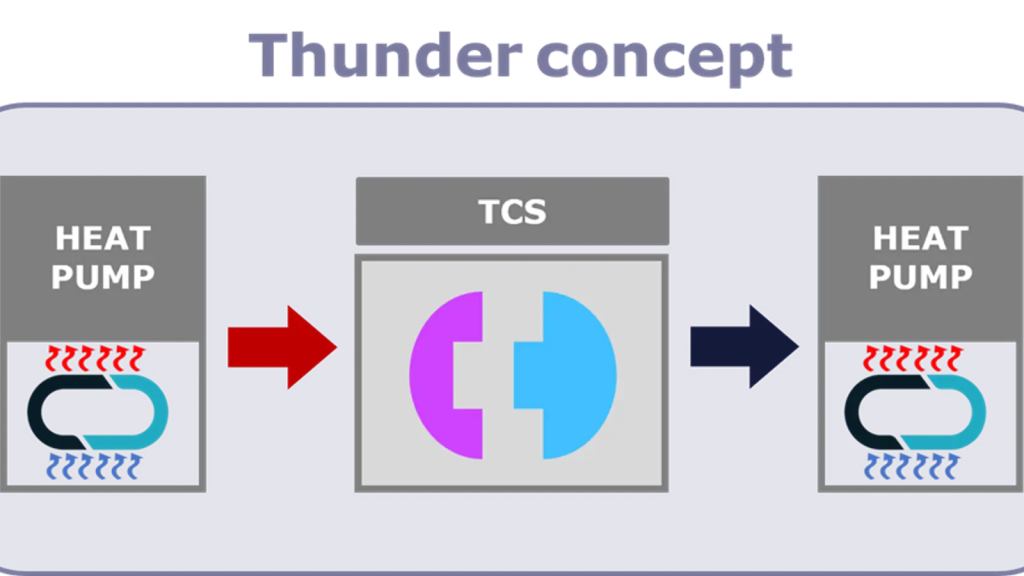The THUNDER project is leveraging seasonal thermochemical energy storage and high-temperature heat pumps to recover and reuse waste heat from data centres.

THUNDER project
The THUNDER project aims to develop a comprehensive strategy for using thermal energy storage systems to enhance energy efficiency, economic viability and environmental sustainability of recovering waste heat from data centres and reusing it in urban district heating networks.
A key technological solution identified by the project is the integration of a seasonal thermal storage system – based on thermochemical materials for heat storage and release – with an innovative high-temperature heat pump. To support this, a numerical simulation tool has been developed to model the entire energy chain, including the individual components and their interconnections.
THUNDER methodology
A comprehensive numerical energy modeling tool is developed to assess the system’s energy performance and to explore alternative scenarios, thereby expanding the range of potential applications.
As part of the THUNDER project, a demonstration site will be established in Varna, Bulgaria, in collaboration with Veolia and Abilix. This site will integrate multiple system components to validate the proposed solution in a real-world setting:
- A data centre that serves as the heat source, operating with a cooling system that produces low temperature waste heat.
- A high temperature heat pump that elevates the temperature of the data centre heat to suitable levels for thermochemical storage charging during summer. The same solution can be used to reach the supply temperature level of the district heating network.
- Seasonal thermal storage using thermochemical materials capable of seasonal energy storage without thermal losses.
- The district heating network that supplies hot water and heating to over 10,000 customers, encompassing a wide range of users.
The simulation tool, developed in Python, has been shaped to replicate the behaviour of the integrated system, including all key components: the data centre, high temperature heat pump, thermochemical material storage, and district heating network.
Simulation tool
The connections between the data centre and seasonal storage and between the seasonal storage and district heating network is represented in figures 1 and 2, the former simulating the charging phase that occurs during the summer and the latter the discharging phase during the winter months.

Figure 1 – THUNDER data centre-thermal storage connection.

Figure 2 – THUNDER thermal storage-district heating network connection.
The colours of the box were chosen as follows: the yellow and orange boxes stand for the information that the different components transmit to each other; the green box represents the boundary conditions; the red boxes are the parameters that the user can decide and finally, the light red boxes are the outputs of the simulation.
The numerical tool enables parametric analysis to support optimisation in a multivariable environment. For example, users can adjust the size and temperature profiles of the data centre, the temperature levels of the district heating network and the size and material of the seasonal thermal storage.
Additionally, the tool can evaluate scenarios involving mobile storage systems – based on phase change materials or sensible heat storage – that can transport heat from the data centre to the district heating network, or in both directions, in cases where a direct connection between the data centre, thermochemical storage and district heating network is not feasible.
Solution technical feasibility
A key achievement of the project is the development of an advanced numerical tool in Python, capable of modeling the entire THUNDER energy chain. Simulation results confirm the technical feasibility and operational flexibility of the proposed solution, demonstrating its adaptability to a wide range of district heating configurations and scenarios.
The system’s ability to store thermal energy with minimal losses and release it on demand during the winter enables more efficient and sustainable operation of urban district heating networks, contributing to the decarbonisation of the heating sector. In addition, the integration of mobile storage systems further enhances the concept’s versatility, allowing implementation even when a direct connection between components is not feasible.
In conclusion, THUNDER marks a significant step toward smarter and more circular energy use, offering a scalable and replicable solution for urban environments across Europe.



